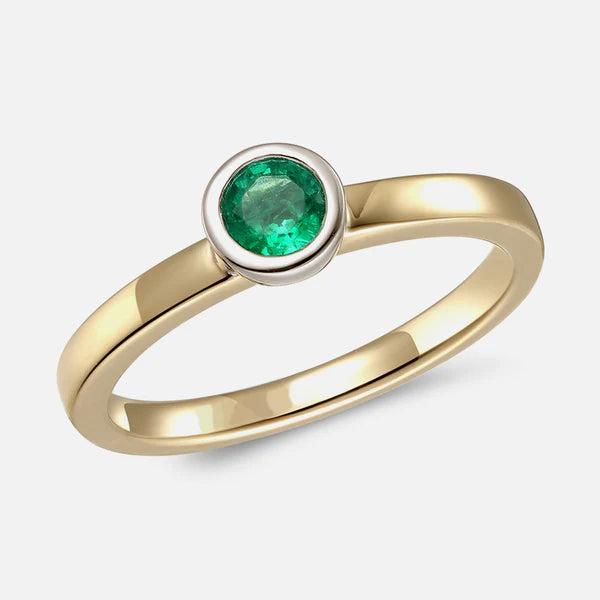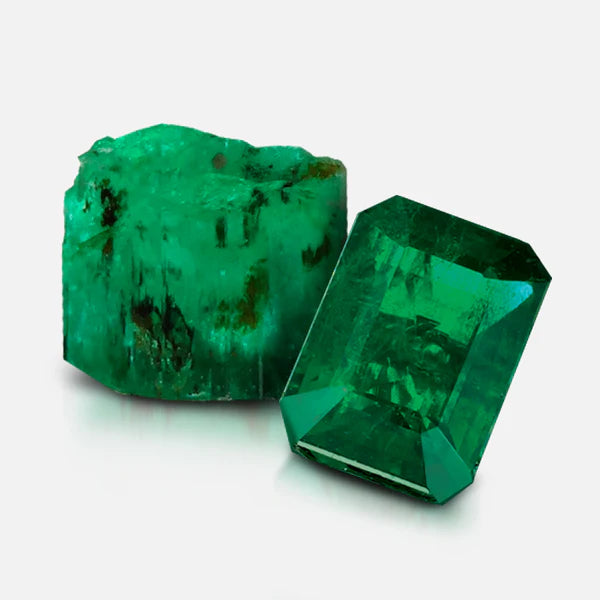Emerald

FUN FACTS
Most emeralds have imperfections; it’s quite rare to find one that doesn’t have what are known as ‘inclusions’ by jewelers. As a result, they’re relative weakness in comparison to other gems makes it harder for them to be made into jewelry.
An emerald pendant once owned by Elizabeth Taylor fetched a whopping $6.5 million when it was sold in 2011.
Emeralds were once believed to act as a sort of ‘truth serum’ to expose cheating partners.
Emeralds are a commonly ‘faked’ stone, with counterfeiters even adding cracks to them to make them appear more authentic.
SELECTION OF JEWELRY
-
Le Vian Grand Sample Sale Earrings featuring Costa Smeralda Emeralds White Diamonds set in 14K Rose Gold
Regular price $1,280.00Regular price -
LeVian Pendant featuring 1/4 cts. Costa Smeralda Emeralds, 1/6 cts. Vanilla Diamonds set in 14K Yellow Gold
Regular price $1,220.00Regular price -
1/2 cts Green Emerald and Diamond 18" Pendant Necklace in 14K Yellow Gold by Le Vian
Regular price $780.00Regular price -
Birthstone Pendant 1 3/8 cts Natural Green Emerald Nude Diamonds 14K Yellow Gold
Regular price $1,090.00Regular price -
Birthstone Earrings 2 1/2 cts Natural Green Emerald Nude Diamond 14K Yellow Gold
Regular price $1,600.00Regular price -
Birthstone Earrings 2 cts Natural Green Emerald Nude Diamonds, in 14K White Gold
Regular price $1,310.00Regular price -
Birthstone Earrings 1 5/8 cts Natural Green Emerald Nude Diamonds, 14K Rose Gold
Regular price $710.00Regular price -
Birthstone Pendant 1 1/4 cts Natural Green Emerald Nude Diamonds 14K Yellow Gold
Regular price $720.00Regular price -
Birthstone Earrings 3 cts Natural Green Emerald Nude Diamonds in 14K Yellow Gold
Regular price $1,500.00Regular price -
Le Vian Ring featuring Costa Smeralda Emeralds Chocolate Diamonds, Nude Diamonds set in 14K Vanilla Gold
Regular price $2,440.00Regular price -
Le Vian Ring featuring Costa Smeralda Emeralds Nude Diamonds set in 14K Honey Gold
Regular price $1,300.00Regular price -
Le Vian Earrings featuring Costa Smeralda Emeralds Vanilla Diamonds set in 14K Strawberry Gold
Regular price $870.00Regular price -
Le Vian Ring featuring Costa Smeralda Emeralds Vanilla Diamonds set in 14K Strawberry Gold
Regular price $1,410.00Regular price -
1 3/8 cts Green Emerald and Diamond Necklace in 14K Rose Gold by Birthstone
Regular price $1,030.00Regular price -
1 cts Green Emerald and Diamond Necklace in 14K Yellow Gold by Birthstone
Regular price $930.00Regular price -
7/8 cts Green Emerald Necklace in 14K Rose Gold by Birthstone
Regular price $520.00Regular price -
3/4 cts Green Emerald Necklace in 14K Rose Gold by Birthstone
Regular price $510.00Regular price -
1/2 cts Green Emerald Necklace in 14K Yellow Gold by Birthstone
Regular price $440.00Regular price -
2 cts Green Emerald and Diamond Earrings in 14K Yellow Gold by Birthstone
Regular price $1,310.00Regular price -
1 1/4 cts Green Emerald and Diamond Necklace in 14K Rose Gold by Birthstone
Regular price $720.00Regular price -
3/4 cts Green Emerald and Diamond Necklace in 14K White Gold by Birthstone
Regular price $530.00Regular price -
5/8 cts Green Emerald and Diamond Necklace in 14K Rose Gold by Birthstone
Regular price $900.00Regular price -
1 5/8 cts Green Emerald Earrings in 14K Yellow Gold by Birthstone
Regular price $1,330.00Regular price -
1 1/2 cts Green Emerald and Diamond Necklace in 14K Yellow Gold by Birthstone
Regular price $1,390.00Regular price -
7/8 cts Green Emerald and Diamond Necklace in 14K Yellow Gold by Birthstone
Regular price $1,200.00Regular price
Find Amazing Jewelry With Emerald

Emerald
ABOUT
Because of its universally renowned green color, the emerald is unsurprisingly associated with nature, regeneration and thus eternity, and meant to have a calming effect and restore equilibrium. It is also believed to be a source of fecundity and a protector against difficult childbirths. Because emeralds are meant to convey a sense of honesty and truthfulness, there is also the belief that they can aid in predicting the future. Although diamonds are often considered the most valuable of gems, very high-quality emeralds are worth more, in large part due to their rarity. Although usually green, they can also come in variants of yellow-green to blue-green.

Emerald
STORY
The gem’s name is simply derived from the very mundane Greek‘smaragdos’, for ‘green gem’. While dating back to antiquity regarding their actual usage, some emeralds are nearly 3 million years old. Egyptians began mining the stone around 1500 BC, and it is said that it was one of Cleopatra’s favorites. The Romans also associated it with Venus, the goddess of love. However, not all associations were positive; people in the Middle Ages believed that emeralds came from Lucifer’s crown, tumbling to the Earth when he fell from Heaven. Although used by the Incas, it was the colonization of the area by the Spanish Empire that subsequently led to the emergence of a worldwide trade of emeralds. They can be found mostly in South America in Colombia and Brazil but are also in large abundance in Zambia.
GEMOLOGICAL SPECIFICATIONS
-
FAMILY
Beryl
-
CHEMISTRY
Be3Al2
-
REFRACTIVE INDEX
1.560 - 1.602
-
BIREFRINGENCE
0.005 - 0.009
-
SPECIFIC GRAVITY
2.63 - 2.92
-
HARDNESS
8



























